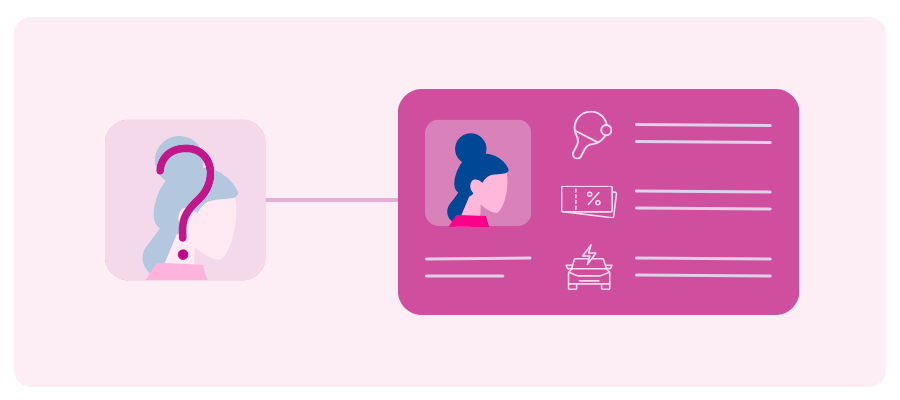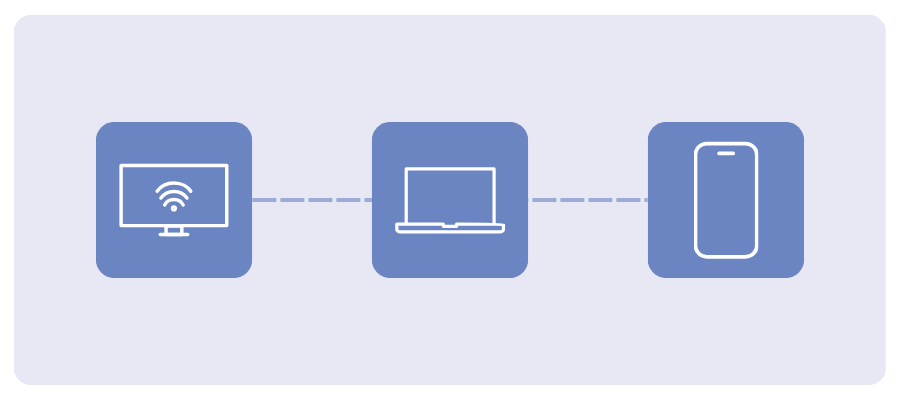At A Glance
Marketers are using AI to better understand audiences, improve efficiency, and build privacy-first identity solutions. At Cannes Lions 2025, leaders shared how AI and structured data help deliver relevant messages, adapt to consumer needs, and build trust. Experian supports this through ethical efforts and innovative solutions.Artificial intelligence (AI) is becoming a bigger part of modern advertising, changing how brands connect with people. At Experian, we believe this technology should make marketing more human, not less. We use AI to help marketers understand consumer behavior, respect privacy, and deliver messages that matter.
As part of our latest Cannes Content Studio series, we spoke with leaders from AdRoll, MiQ, OpenX, Optable, PMG, PubMatic, and Yieldmo. Their insights show a clear path forward; one where technology supports human strategy to create more meaningful connections.
1. How does AI help you see audiences more clearly?

AI decodes complex behavioral signals to reveal the values and mindsets behind decisions, and increasingly, it predicts what audiences will care about next. This allows marketers to deliver timely, relevant messages that resonate with audiences. At Experian, we help brands use these insights to connect more meaningfully and ethically.
Takeaway: Experian’s tools help brands uncover audience insights, enabling more meaningful and ethical connections.
2. Where does AI actually save time, and improve results?

Running campaigns is time-consuming. Solutions like Agentic AI now orchestrate end-to-end campaign workflows, audience building, trafficking, QA, pacing, and routine optimizations, so teams focus on strategy and creativity. Many leaders (94%) are investing broadly in AI to drive efficiency and impact, and 49% of marketers use it daily for image and video generation, shifting repetitive tasks from people to tools. By quickly combining past and current performance data, AI can pre-optimize before launch and refine mid-flight, while marketers steer the message and experience.
“AI uses past campaign data to optimize performance before launch, continues learning during the campaign, and refines strategies based on the insights it generates, driving better results over time.”
PubMaticHoward Luks
Takeaway: Experian’s solutions streamline campaign workflows, allowing marketers to focus on creativity and strategy while improving results.
3. How do AI and human strategy work together in real time?

AI handles real-time data analysis and optimization, freeing marketers to focus on strategy, messaging, and creativity. By defining audiences once and activating them across platforms, teams can adapt quickly and confidently. At Experian, we combine machine intelligence with human insight to deliver smarter, more agile campaigns.
“AI analyzes data, pulls insights, and automates optimizations, allowing marketers to focus on strategy, messaging, and creativity instead of spending time digging through numbers and data.”
AdRollLizzie Chapman
Takeaway: Experian solutions empower marketers to adapt quickly and confidently, combining human strategy with insights.
4. What does privacy-first look like now?

Relying on simple, static data points is no longer enough. A modern approach to identity blends deterministic data (like known identifiers) with modeled components, ensuring data remains de-identified where possible. Clear, transparent guardrails, permitted-use policies, retention limits, sensitive-category blocks, and audit trails, help brands balance personalization with privacy, build trust, and respect user choice.
“A new blend of identity systems combines deterministic data, known identifiers, and model driven components, creating fresh ways to address identity and activate campaigns with precision.”
OptableVlad Stesin
Takeaway: Experian’s privacy-first identity solutions help brands balance personalization with safety, ensuring trust and compliance.
5. Which new data signals matter, and why?

AI is unlocking a new generation of data signals, like content context, sentiment, emotional tone, suitability, attention, and commerce intent, that go beyond legacy identifiers like cookies and demographics. These signals can help brand messages appear in the most relevant environments and by high-value audiences. Used well, they improve relevance, avoid placements near unsuitable or off-brand content, and drive stronger campaign outcomes.
“Unlocking new data sets (like emotion, sentiment, and context), AI is creating innovative ways to connect client content with advertising opportunities and rethink how we approach the market.”
PMGSam Bloom
Takeaway: Experian’s solutions use advanced data signals to help marketers create more effective and innovative campaigns.
Why Experian for human-centered AI?

We deliver on the promise of AI-powered marketing through five pillars:
- See audiences clearly across households, individuals, and devices.
- Recommend next‑best audiences and automate setup for faster execution.
- Adapt in real‑time to keep relevance high.
- Innovate responsibly with strong governance and transparency.
- Plan, activate, and measure campaigns on one unified platform.
The future of intelligent marketing

AI will keep accelerating, but the goal stands: make marketing more human. Teams that blend privacy‑first identity, predictive insight, AI‑powered simplicity, and real‑time intelligence will earn trust and drive outcomes. Experian helps you bring those pieces together so every campaign moves from assumptions to clarity, and from activity to measurable results.
Talk to Experian about building human-centered AI into your marketing strategy
AI marketing trends FAQs
AI analyzes complex signals, behaviors, values, and mindsets to provide a clearer picture of what matters to audiences. That clarity makes messaging feel personal and relevant. Learn more about Experian’s Digital Graph and how it can help marketers understand audiences better.
Automation reduces manual setup and reporting, so teams focus on strategy and creative. Nearly half of marketers (49%) use AI daily for image and video generation, reflecting this shift.
Smarter activation across platforms means defining audiences once, then carrying them across channels with live feedback, so relevance and suitability stay high. See how Experian enables smarter activation with our data and identity solutions.
Privacy‑first identity blends deterministic and modeled components, keeping data de‑identified where possible. Experian’s solutions balance personalization with safety. Learn about Experian’s identity solutions is changing identity.
AI systems rely heavily on brand‑managed sources. 86% of citations come from websites, listings, and reviews, so clean, accurate, structured data makes your answers and your brand more discoverable. Discover how Experian supports structured data for AI-driven marketing.
Latest posts

In this article…How much standardization currently exists?Why is standardization important?Who is promoting standardization?The benefits of industry standardizationStrategies for implementing retail media standardizationFuture retail media standardization trendsJoin forces with a strategic RMN partner Retail media is quickly outpacing other areas of digital advertising and is projected to grow 29% by 2025. Despite this trajectory, retail media is still relatively new compared to traditional digital media and operates like a startup in terms of tech capabilities. Sustained growth will require retail media standardization — creating consistent ways to measure and compare ad performance across retail media networks (RMNs). This standardization will be key for RMNs wanting to understand what’s driving the most value and sales for their business. In an Interactive Advertising Bureau (IAB) study, 62% of ad buyers pointed to standardization as a top growth challenge. The current ecosystem’s inconsistent standards have prevented effective investment in measurement and limited ad buyer participation. Standardization will be necessary moving forward for effective adoption and trust in these new channels. This article explores the challenges marketers face without retail media standardization and the collaborative efforts needed to establish consistent measurement standards across the industry. How much standardization currently exists? Retail media standardization is limited industry-wide, with each RMN using its own metrics and definitions; what one network calls a "conversion" might be defined differently by another. Some retail companies also sell ad space within siloed, walled-garden shopping environments, which makes it difficult for advertisers to compare performance across platforms. As a result, the current landscape lends itself to inconsistency, campaign measurement complications, and an unclear view of return on investment (ROI) across RMNs. This fragmentation stems from how retailers have historically developed and managed customer data platforms and e-commerce websites independently, causing disparities in the types and quality of customer data available and the technologies used to manage it. Each retailer uses a unique technology stack and customer experience strategies, which means data is collected, utilized, and integrated into advertising platforms differently. Why is standardization important? A 2023 State of Retail Media Survey highlighted the industry's lack of standardization as a significant obstacle to growth. The Association of National Advertisers also found that advertisers can't fully take advantage of their retail media investments because of inconsistent measurement practices. Standardized retail media measurement practices are critical for growth. By setting consistent measurement standards across different platforms, it becomes easier for various players to: Assess how ads are performing See which strategies work across RMNs Optimize ad spending Make informed decisions Extract more value from advertising budgets Ultimately, standardized metrics are a must for improving transparency, strategic effectiveness, and ROI. Who is promoting standardization? We’re seeing a collective push for retail media standardization by several industry stakeholders wanting a more cohesive and effective advertising ecosystem. One of the most recent efforts came from the IAB and the Media Rating Council (MRC). These organizations collaborated with brands, agencies, and RMNs to develop new guidelines for standardized measurement practices and have given the ecosystem a proposed common language for retail media measurement. These guidelines were released in January 2024 to provide a consistent framework for the following across retail media platforms: Audience measurement Reporting Incrementality Transparency Viewability Ad delivery In-store advertising Microsoft Retail Media, an early adopter of the framework, has experienced greater data transparency, accuracy, privacy, and security, which has benefited advertisers and retailers and advanced Microsoft’s position as a retail media industry leader. Widespread adoption of these guidelines has the potential to drive innovation, attract more advertisers, strengthen collaboration, grow the industry, and improve the consumer experience. The benefits of industry standardization A standardized retail media framework for performance measurement can benefit advertisers, retailers, media agencies, and other stakeholders in the ecosystem. Here are some ways each entity stands to benefit. Benefits for retailers Standardization makes it easier for retailers to demonstrate their credibility and the value of their retail media program. With uniform measurement across channels and campaigns, they can provide clear, comparable data that reflects their impact, builds trust, and encourages advertiser investment. Better campaign management efficiency also reduces the operational burden, so retailers can focus on improving customer experiences and driving sales. Experian’s Activity Feed helps you measure performance — and understand how ads impact shopping behavior — by providing you with ad exposures in one environment (web or connected TV) that you can connect to an action in another (in-store purchase). Learn more about Activity Feed and see it in action here. Benefits for media agencies and marketers With standardized metrics, advertisers and media agencies have an easy, reliable way to compare metrics and assess the effectiveness of various campaigns across RMNs. This “apples to apples” comparison helps them determine which channels are truly driving better ROI so they can effectively optimize spending. Standardization also improves collaboration with retailers and leads to more effective campaigns. Consistent guidelines can help teams create, carry out, and optimize retail media strategies and easily compare platform effectiveness. Benefits for industry stakeholders Industry stakeholders like technology providers and regulatory bodies can greatly benefit from standardized retail media measurement practices. Consistent measurement provides a common framework that improves transparency and trust among parties. With reliable and comparable metrics, standardization helps everyone speak the same language when it comes to performance evaluation and decision-making. This uniformity facilitates smoother interactions and partnerships between the buy and sell sides, so it’s easier to negotiate and collaborate. Strategies for implementing retail media standardization Standardizing measurement will require industry-wide coordination around several strategies, as outlined in best practices frameworks from standardization proponents like IAB/MRC and the Albertson's Media Collective. Unify reporting and performance measurement To address the lack of standardization in performance metrics, RMNs must adopt uniform definitions and calculation methodologies for key metrics. Unified reporting in retail media requires successful stakeholder collaboration to: Agree on critical KPIs and reporting metrics like impressions and conversion rates Adopt standardized data formats and reporting tools Educate stakeholders Ensure data quality and compliance Continuously improve based on industry feedback The IAB/MRC framework provides a basis for standardizing metrics for media delivery and engagement, as well as sales and conversions. This consistency helps advertisers compare performance across platforms effectively, enhancing transparency and decision-making. Standardize product specifications It's important for advertisers to have consistent product specifications, as it makes it easier to create and deploy ads across multiple RMNs. To achieve this, RMNs should align ad formats, file sizes, animations, and video specifications with IAB guidelines. Following these standards will help RMNs eliminate compatibility issues, simplify adoption, and save time and resources. It's also vital for RMNs to maintain flexibility for unique ad formats in order to encourage innovation while still benefiting from standardized specifications. Introduce third-party verification and disclose capabilities Introducing third-party verification for ad placement, fraud detection, brand safety, and competitive separation can improve an RMN’s credibility and transparency. By disclosing the third-party providers used and the types of verification offered, RMNs build trust with advertisers and give them the confidence they need to invest. Additionally, RMNs should disclose their staffing, processes, technology, inventory management, targeting, creative management, and self-service offerings. Transparency in these areas helps advertisers make informed decisions, optimize ad buys, and increase efficiency. Using existing IAB verification and capability disclosure guidelines ensures reliability and a more trustworthy, efficient advertising environment. Future retail media standardization trends The future of retail media is poised for significant growth, especially as standardization guidelines are widely adopted and implemented. Here are some trends we expect to see as retail media ad spending grows. Widespread RMN adoption and spending Standardization could spur greater RMN spending and drive broad adoption by advertisers who hesitated before due to concerns about metrics and performance comparability. New partnerships and collaborations Standardization may lead to new partnerships that weren't possible before: Brands and retailers might team up to blend advertising and sales data for better-targeted campaigns. AdTech companies could also partner with multiple retailers to offer unified advertising solutions. Retail media networks and analytics firms could collaborate to provide deep insights into consumer behavior and campaign performance. Partnerships among retailers, including smaller ones seeking retail media measurement uniformity, may drive further standardization and create new advertising opportunities across product categories with audience overlap. Ad format innovation Agreeing on common standards simplifies how ads are measured and understood. Standardization may drive down costs and free up space for more imaginative, engaging ads in the future. For instance, the IAB/MRC’s common language is helping to promote consistency and clarity and fuel innovation across the board. Incrementality focus As standardization becomes more widespread, there may be a growing trend toward incrementality measurement, which measures the additional impact of advertising campaigns compared to what would have happened without them. Standardized metrics can help advertisers accurately gauge and optimize campaign effectiveness and maximize their marketing investments. Growth of cross-platform ad targeting Standardization may drive the growth of cross-platform ad targeting. With consistent metrics and measurement standards, advertisers will be able to track and compare their ad performance across platforms more accurately. This unified approach will improve ad targeting precision and ensure a consistent impact across RMNs. Commerce media Commerce media is changing retail advertising with its focus on verified data and real-time transaction insights, making campaigns more efficient. This shift could push for more uniform measurement standards across platforms and level the playing field. As commerce media gains traction, its emphasis on targeted advertising and ROI measurement might pave the way for universal metrics and clearer guidelines across retail networks. Where does this leave modern advertisers? Retail media is still at a crossroads. If standardization doesn’t occur soon, its growth may slow. For now, advertisers are resorting to custom strategies or relying on whichever network they feel is most effective for their products. They are likely to continue investing significantly in retail media, maintaining or increasing spending in the next year. Although RMNs continue to be challenging without formally recognized standardization guidelines, the proposed IAB/MRC guidelines provide an effective starting point. Join forces with a strategic RMN partner RMN success requires overcoming complicated technical hurdles that may exceed non-media business capacities. Managing data complexities, resolving identities, utilizing audience insights, and ensuring precise measurement requires specialized expertise and technologies. We recently announced a solution tailored for RMNs. This offering enhances RMNs’ strength in first-party shopper data by using Experian’s #1 ranked identity and audience services. Our solution helps RMNs unlock expanded customer insights, enriched audiences for activation, identity resolution for cross-channel audience targeting, and real-time measurement and attribution. This comprehensive solution is designed to help RMNs capture more advertising revenue. Read the full announcement If your organization could benefit from a partner with the requisite technological tools and insights into the retail media landscape, contact us to discover how we can help you achieve RMN success. Contact us Latest posts

With over one billion shoppers eagerly preparing to shop for gifts, decorations, and seasonal essentials, now is the perfect time to refine your marketing tactics and connect with these shoppers. With holiday retail sales set to reach $1.37 trillion, it’s time to unwrap holiday spending insights to ensure that your holiday advertising campaigns light up the festive season. The holiday shopping frenzy offers marketers and retailers a chance to capture attention, drive sales, and build lasting customer relationships. In this blog post, we’ll reveal holiday shopping audiences, including 19 new audiences, designed for you to reach the most relevant shoppers for your campaigns. These audiences are available for activation on-the-shelf of most major ad platforms, including TV and programmatic. You can find the complete audience segment name in the appendix. 2025 Holiday spending trends and insights report Download our latest report for data-driven insights you can use to refine your messaging and reach the right audience in their preferred channels this holiday season. Download now What separates Experian's syndicated audiences Experian’s 2,400+ syndicated audiences are available directly on over 30 leading television, social, programmatic advertising platforms, and directly within Audigent for activation within private marketplaces (PMPs). Reach consumers based on who they are, where they live, and their household makeup. Experian ranked #1 in accuracy by Truthset for key demographic attributes. Access to unique audiences through Experian’s Partner Audiences available on Experian’s data marketplace, within Audigent for activation in PMPs and directly on platforms like DirectTV, Dish, Magnite, OpenAP, and The Trade Desk. Download our 2024 holiday shopping report Holiday shopping styles It's important to understand how your holiday shopper “shops,” with individual shopping styles varying from a last-minute dash to the store to the one-stop shopper. One in three consumers anticipate beginning their holiday shopping before October this year, with Millennials and Gen Xers being the most proactive, due to concerns about items running out of stock. In contrast, 42% of Boomers are generally less inclined to shop early, wanting to start their holiday shopping in November or December. All generations are motivated to shop early by discounts.1 By choosing and activating the right audience segments, you can deliver messages that resonate with the consumer's preferred shopping style, ensuring your holiday campaign will align with their shopping preferences and behaviors. Here are five audiences that you can activate based on shopping style: Last-Minute Holiday Shoppers One Stop Holiday Shoppers/Power Shoppers: In-Store or Online Impulse Buyers eCommerce Diehards Brick & Mortar Diehards Discount-seeking shoppers The holiday season is a time of giving, but also saving! Consumers are driven to shop early by discounts and early sales — 52% of consumers said discounts are their biggest motivator to shop early. Price is another crucial factor — 47% of consumers said price is the most important factor when deciding where to shop during the holiday season. Major holiday shopping events, such as Thanksgiving Day, Black Friday, and Cyber Monday, are expected to attract a significant portion of consumers this upcoming year.2 Here are eight audiences you can activate to reach discount-seeking shoppers: NEW! Discount Holiday Shoppers NEW! Cyber Monday Holiday Shoppers NEW! Black Friday Holiday Shoppers NEW! Big Box/Club Stores Holiday Shoppers NEW! Online Coupon Users TrueTouch: Online Coupon Site Department Store Deal Shoppers: In-Store or Online Post Holiday Shoppers Gift givers Holiday shoppers are torn between saving and splurging. Nearly a third of consumers anticipate spending more on holiday shopping this year, while the same number of consumers say they’ll be spending less. Boomers anticipate spending the most on gift cards, Gen Z on clothing, and Millennials on toys, electronics, and experiences.3 Given holiday shoppers' varied spending habits, it's important to target the right audience segments to maximize your impact. Targeting specific audience segments allows advertisers to better reach those most interested in their products. Here are six audiences you can activate to target gift givers: NEW! Luxury Gift Shoppers NEW! Holiday Shopping High Spenders NEW! Holiday Shopping Moderate Spenders NEW! Holiday Charitable Donations High Spend Gift Shoppers Heavy Buyer/Spenders Holiday Shoppers: In-Store or Online Holiday travelers In 2023, nearly three million travelers passed through airports on the Sunday after Thanksgiving alone. Take advantage of the busy travel season with our audience segments. By targeting specific travel preferences and behaviors, you can capture the attention of individuals planning trips this holiday season. Here are seven audiences to tailor your campaign according to travel preferences: NEW! Holiday International Travelers NEW! Holiday Travel-Train NEW! Holiday Budget Savvy Airline Travelers Vacation/Leisure Travelers: Domestic Trips Air Travel (FLA/Fair Lending Friendly)4 Vacation/Leisure Travelers: Frequent Spenders Hotels: Frequent Spend When you work with Experian, you work with a single data provider that gives you access to audiences across multiple verticals and categories, such as travel and retail. Targeted advertising this holiday season with Experian audiences The holiday season is the busiest time of the year for advertisers. Experian's data, ranked #1 in accuracy by Truthset, allows advertisers to reach people based on demographic, geographic, and behavioral attributes (e.g. websites visited and purchase history). By using Experian’s audiences in your holiday advertising campaigns, you can reach last-minute shoppers, discount-seeking shoppers, gift-givers, and holiday travelers. Just as shoppers seek the perfect gifts, with the right strategy, your holiday advertising campaigns can capture the right shoppers this holiday season. Need a custom audience? Reach out to our audience team and we can help you build and activate an Experian audience on the platform of your choice. Additionally, work with Experian’s network of data providers to build audiences and send to an Audigent PMP for activation. Connect with our audience team You can activate our syndicated audiences on-the-shelf of most major platforms. For a full list of Experian’s syndicated audiences and activation destinations, download our syndicated audiences guide. Explore our other seasonal audiences that you can activate today. View now Download our 2025 Holiday spending trends and insights report This holiday season is about more than just transactions – it’s about cultivating meaningful connections with your audience. Download our 2025 Holiday spending trends and insights report, in collaboration with GroundTruth, to access all of our predictions for this year’s holiday season. Download now Contact us Footnotes Online survey conducted in June, 2024 among n=1,000 U.S. adults 18+. Sample balanced to look like the general population on key demographics (age, gender, household income, ethnicity, and region). n = 204 Gen Z, n = 234 Millennials, n = 270 Gen X, n = 272 Baby Boomers. Online survey. Online survey. “Fair Lending Friendly” indicates data fields that Experian has made available without use of certain demographic attributes that may increase the likelihood of discriminatory practices prohibited by the Fair Housing Act (“FHA”) and Equal Credit Opportunity Act (“ECOA”). These excluded attributes include, but may not be limited to, race, color, religion, national origin, sex, marital status, age, disability, handicap, family status, ancestry, sexual orientation, unfavorable military discharge, and gender. Experian’s provision of Fair Lending Friendly indicators does not constitute legal advice or otherwise assures your compliance with the FHA, ECOA, or any other applicable laws. Clients should seek legal advice with respect to your use of data in connection with lending decisions or application and compliance with applicable laws. Appendix Here are the complete audience segment names (taxonomy paths) for all audience segments discussed in this blog post. Holiday shopping styles Retail Shoppers: Purchase Based > Seasonal > Holiday Shoppers: Last-Minute Holiday Shoppers Retail Shoppers: Purchased Based > Seasonal > Holiday Shoppers: One Stop Holiday Shoppers/Power Shoppers: In-Store Retail Shoppers: Purchased Based > Seasonal > Holiday Shoppers: One Stop Holiday Shoppers/Power Shoppers: Online TrueTouch: Communication Preferences > Purchase Behavior > Impulse buyers Retail Shoppers: Purchase behavior > Shopping Behavior > In-Store vs. Online: eCommerce Diehards Retail Shoppers: Purchase behavior > Shopping Behavior > In-Store vs. Online: Brick & Mortar Diehards Discount-seeking shoppers NEW! Retail Shoppers: Purchase Based > Seasonal > Holiday Shoppers: Cyber Monday NEW! Retail Shoppers: Purchase Based > Seasonal > Holiday Shoppers: Black Friday NEW! Retail Shopper: Purchase Based > Seasonal > Holiday Shoppers: Big Box/Club Stores Shoppers NEW! Retail Shoppers: Purchase Based >> Discount Holiday Shoppers NEW! Retail Shoppers: Purchased Based > Shopping Behavior > Online Coupon Users TrueTouch: Communication Preferences> Purchase Behavior > Online Coupon Site Retail Shoppers: Purchased Based > Shopping Behavior > Department Store Deal Shoppers Online Spenders Retail Shoppers: Purchased Based > Shopping Behavior > Department Store Deal Shoppers In-Store Spenders Retail Shoppers: Purchased Based > Seasonal > Holiday Shoppers: Post holiday Gift givers NEW! Retail Shoppers: Purchase Based > Seasonal > Holiday Shoppers: Luxury Gift Shoppers NEW! Retail Shoppers: Purchase Based > Seasonal > Holiday Shoppers: High Spenders NEW! Retail Shoppers: Purchase Based > Seasonal > Holiday Shoppers: Moderate Spenders NEW! Retail Shoppers: Purchase Based > Seasonal > Holiday Charitable Donations Retail Shoppers: Purchase Based > Shopping Behavior > Gift Shoppers High Spend Spenders Retail Shoppers: Purchase Based > Seasonal > Holiday Shoppers: Heavy Buyer/Spenders: Online Retail Shoppers: Purchase Based > Seasonal > Holiday Shoppers: Heavy Buyer/Spenders: In Store Holiday travelers NEW! Retail Shoppers: Purchase Based > Seasonal > Holiday International Travelers NEW! Retail Shoppers: Purchase Based > Seasonal> Holiday Travel-Train NEW! Retail Shoppers: Purchase Based > Seasonal > Holiday Budget Savvy Airline Travelers Retail Shoppers: Purchase Based > Travel > Vacation/Leisure Travelers: Domestic Trips Lifestyle and Interests (Affinity) > Travelers > Air Travel (FLA/Fair Lending Friendly) Retail Shoppers: Purchase Based > Travel > Vacation/Leisure Travelers: Frequent Spenders Retail Shoppers: Purchase Based > Travel > Hotels: Frequent Spend Latest posts

In our Ask the Expert Series, we interview leaders from our partner organizations who are helping to lead their brands to new heights in ad tech. Today’s interview is with Jordan Feivelson, VP, Digital Audiences at Webbula. Jordan is a 22-year advertising industry veteran who has worked for media properties such as WebMD and Disney. Over the past ten years, he has transitioned to the data and programmatic space, including growing the data business for Kantar Shopcom and Adstra. What types of advertisers might benefit from utilizing Webbula audiences across various verticals? Can you provide examples of how different industries successfully leverage your data to achieve specific campaign goals? Most advertisers can leverage Webbula’s award-winning attributes for their activation initiatives. Webbula offers approximately 3,000 syndicated segments covering categories such as Demographics, Automotive, Political, Mortgage, B2B, Hobby/Interest/Lifestyle, and Interests & Brand Preferences (brand name targeting). Audience insights and marketing strategies What specific types of audience segments does Webbula provide? How can advertisers leverage these segments to craft more effective, personalized marketing strategies? Webbula has incredible depth and breadth within its verticals, giving marketers the tools to deliver targeted messaging effectively. Our Demographic, B2B, Mortgage, Automotive, and Interest and Brand Preferences segments each contain 500-1,000 segments, all built on deterministic, self-reported, and individually linked data. We ensure the best accuracy with multiple deterministic data points tied to the real world (ex., first name, last name, postal address, and email address). Some examples of our unique syndicated audience types: B2B: A view of the latest industry trends with detailed cuts of the professional world, such as companies with and not within the Fortune 500 companies and job positions that are directors and below. This also includes custom capabilities, including ABM (list of target companies in an activation campaign or by industry code (ex. NAICS, SIC). Interest and Brand Preferences: Consumers who have shown interest and affinity to hundreds of brands (ex., Nike), genres (ex., comedy, hip hop), sports teams, and more. Mortgage: A detailed view of homebuyers’ purchase range, loan type (ex. jumbo loan, standard loan), mortgage amount, interest rate, and more. With Webbula’s audience data, brands can create a comprehensive picture of their audiences down to the individual level and reach them accurately. Data quality, sourcing, and differentiation How is consumer data sourced and curated at Webbula? Are there data quality standards that Webbula establishes for consumer data, and how do you ensure your sources and methods meet these standards consistently? Webbula’s data is aggregated from over 110 trusted and authenticated sources, including publishers, data partners, social media, and more. The data collected comes directly from consumers who self-report information through surveys and other methods. We apply our hygiene filters to mitigate fraud and accurately score the data. Data Collection: The data collected comes directly from consumers who self-report information through surveys, questionnaires, transactions, and sign-ups. This ensures that brands display ads to audiences based on self-identified, cross-channel behaviors, not modeled assumptions. Hygiene Solutions: Webbula applies multi-method hygiene solutions to mitigate fraud and accurately score the data before onboarding, ensuring that all data meets the highest quality standards. Examples of Data Sources: Questionnaires: Self-reported data through surveys, offer submissions, and telemarketing. Transactions: Deterministic data from aftermarket parts, online purchases or services, and more. Sign-ups: Individually linked data from information entered through sweepstakes, infomercials, newsletters, and forms. What differentiates Webbula's data from other data providers in the market? Can you explain the unique value proposition that Webbula offers in terms of data depth and breadth? Due to our extensive experience in data cleansing, we provide the most accurate data within the programmatic ecosystem. TruthSet, the leading programmatic accuracy measurement company, has ranked Webbula as having the highest number of top attributes compared to other data providers with 150M+ HEMs. Additionally, Publicis Groupe and Neutronian further validate Webbula's data quality, underscoring its position as a leader in the industry. Webbula's data stands out in the market due to its unmatched accuracy and quality, achieved through years of expertise in data cleansing. Unlike other providers, Webbula’s foundation lies in its robust email hygiene process, ensuring that all data entering the programmatic ecosystem is thoroughly cleansed. Privacy, compliance, and future-proofing What measures does Webbula take to maintain data privacy and compliance? How do these efforts benefit advertisers in an evolving regulatory landscape and ensure ethical standards? Webbula was created over a decade ago with a future-proof, privacy-compliant foundation. We understand the industry’s rapid changes, including government and state legislation and cookie depreciation. Our goal has always been to build long-term partnerships and ensure we are prepared for industry changes. We rely on validated offline data sources, making us resilient to external influences. Success stories Can you share success stories where advertisers saw significant campaign improvements using Webbula’s data? What were the key factors that contributed to these successes? Our success is measured by client feedback and increased client spend. Webbula has helped several key advertisers achieve six-figure monthly thresholds by providing the most accurate data to meet campaign KPIs. Clients consistently return to use our data, validating our belief that “the proof is in the pudding.” Thanks for the interview. Any recommendations for our readers if they want to learn more? For those interested in learning more about Webbula, reach out for a personalized consultation. Contact us Latest posts